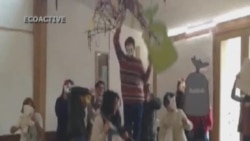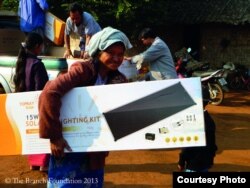An estimated one billion people around the world mark Earth Day each April 22, making this environmental celebration one of the largest civic observances on the planet.
At its hub is the Earth Day Network, the not-for-profit organization whose founders launched the first Earth Day in 1970. The network has helped promote the event ever since.
This year’s theme is The Face of Climate Change. The campaign harnesses the Internet and social media to create a worldwide digital display of people, places and wildlife that have been affected by climate change.
Virtual wall
Franklin Russell, director of Earth Day for the Earth Day Network and the Face of Climate Change campaign, wants your face on his virtual wall. The network’s 20,000 partner groups are helping spread the word.
“We had a couple of photos coming from India recently, from students who were using recycled plastic bags to make pots for their plants," Russell said. "We had a bunch of people take to the streets in Bulgaria to protest deforestation and to demand the government start taking action.”
The web-based campaign is collecting thousands of digital photos from Facebook, Instagram and other social media, which link to earthday.org.
“The key is engaging as many people as possible… to take a photo of themselves, depicting either the impact of climate change or even some of solutions that they are engaged in," Russell said, "and share with us and allow us to build this really impressive digital mosaic that we can share with the world to influence change.”
Vivid mosaic
That mosaic, which appears as a scanable wall of photos, is mesmerizing. You can stop on a photo, click on it to turn it over, read more on the back and join a live Twitter feed to comment on what you see.
The image of a young girl named Stephanie jumps out. She’s on a glacier in New Zealand and laments that warming temperatures have made it impossible to climb certain peaks.
Another photo shows women in Kenya learning to use newly-designed cook stoves that are more efficient, less polluting and safer to operate.
We also meet Sarah Vant, an educator with a non-profit group in England called EcoActive. She works with people of all ages to explore solutions to environmental problems.
Polo, Vant's polar bear puppet, helps Vant explain to young children how to take care of the environment and the dangers we face if we don’t.
“If I talk about the polar bears, he might get a bit sad," Vant said. "Or if a child comes up with a brilliant idea for saving energy or reducing the emission waste that their family might be using, he might get really excited and maybe do a little dance, just anything to make it exciting.”
Solar-powered refugee camp
Another human face transports us to a refugee camp on the Thai-Burmese border. We see a 75-year-old woman carrying a solar panel to install on her thatched-roof hut.
Six-hundred refugees from Burma have lived there since 2007. They are caught in a web of ethnic divisions and politics. They can’t go home. Worse, the camp is not recognized by either the United Nations or Thailand. And until The Branch Foundation stepped in, it had no electricity.
“We are the face of climate change because we are the first solar-powered refugee camp in the world,” said Iona Proebst, executive director and founder of The Branch Foundation, a not-for-profit group that helps marginalized people in Southeast Asia.
She's watched the solar panels change daily life at the camp.
“Kids’ grades have gone up in school," said Proebst. "There have since been no fires and no one has gotten burnt. Due to the solar panel project, the money that the residents save on kerosene lamps and candles, they can now buy their own yellow beans.”
Yellow beans are an important source of protein which camp residents couldn’t afford before. The project has given the refugees pride and renewed hope.
“I think that it sets an amazing example of a small amount of dedicated individuals wanting to create sustainable change," said Iona Proebst. "In terms what you might think of renewable energy [project] a kind of unlikely suspect. But, yet it has worked fantastically well in terms of benefit.”
The Earth Day Network brings these people together for the entire world to meet. In this collective narrative there is also a photo of a child from Cameroon raising his hand in a pledge to protect the planet. Other photos show children planting trees.
Ngong Edwin Nkainin, director of the Rural Community Center for Agriculture, who sent the pictures, said, “These children are climate advocates. Imagine what 100 children will do.”
Which prompts the question: on Earth Day, what can one billion people do?
At its hub is the Earth Day Network, the not-for-profit organization whose founders launched the first Earth Day in 1970. The network has helped promote the event ever since.
This year’s theme is The Face of Climate Change. The campaign harnesses the Internet and social media to create a worldwide digital display of people, places and wildlife that have been affected by climate change.
Virtual wall
Franklin Russell, director of Earth Day for the Earth Day Network and the Face of Climate Change campaign, wants your face on his virtual wall. The network’s 20,000 partner groups are helping spread the word.
“We had a couple of photos coming from India recently, from students who were using recycled plastic bags to make pots for their plants," Russell said. "We had a bunch of people take to the streets in Bulgaria to protest deforestation and to demand the government start taking action.”
The web-based campaign is collecting thousands of digital photos from Facebook, Instagram and other social media, which link to earthday.org.
“The key is engaging as many people as possible… to take a photo of themselves, depicting either the impact of climate change or even some of solutions that they are engaged in," Russell said, "and share with us and allow us to build this really impressive digital mosaic that we can share with the world to influence change.”
Vivid mosaic
That mosaic, which appears as a scanable wall of photos, is mesmerizing. You can stop on a photo, click on it to turn it over, read more on the back and join a live Twitter feed to comment on what you see.
The image of a young girl named Stephanie jumps out. She’s on a glacier in New Zealand and laments that warming temperatures have made it impossible to climb certain peaks.
Another photo shows women in Kenya learning to use newly-designed cook stoves that are more efficient, less polluting and safer to operate.
We also meet Sarah Vant, an educator with a non-profit group in England called EcoActive. She works with people of all ages to explore solutions to environmental problems.
Polo, Vant's polar bear puppet, helps Vant explain to young children how to take care of the environment and the dangers we face if we don’t.
“If I talk about the polar bears, he might get a bit sad," Vant said. "Or if a child comes up with a brilliant idea for saving energy or reducing the emission waste that their family might be using, he might get really excited and maybe do a little dance, just anything to make it exciting.”
Solar-powered refugee camp
Another human face transports us to a refugee camp on the Thai-Burmese border. We see a 75-year-old woman carrying a solar panel to install on her thatched-roof hut.
Six-hundred refugees from Burma have lived there since 2007. They are caught in a web of ethnic divisions and politics. They can’t go home. Worse, the camp is not recognized by either the United Nations or Thailand. And until The Branch Foundation stepped in, it had no electricity.
“We are the face of climate change because we are the first solar-powered refugee camp in the world,” said Iona Proebst, executive director and founder of The Branch Foundation, a not-for-profit group that helps marginalized people in Southeast Asia.
She's watched the solar panels change daily life at the camp.
“Kids’ grades have gone up in school," said Proebst. "There have since been no fires and no one has gotten burnt. Due to the solar panel project, the money that the residents save on kerosene lamps and candles, they can now buy their own yellow beans.”
Yellow beans are an important source of protein which camp residents couldn’t afford before. The project has given the refugees pride and renewed hope.
“I think that it sets an amazing example of a small amount of dedicated individuals wanting to create sustainable change," said Iona Proebst. "In terms what you might think of renewable energy [project] a kind of unlikely suspect. But, yet it has worked fantastically well in terms of benefit.”
The Earth Day Network brings these people together for the entire world to meet. In this collective narrative there is also a photo of a child from Cameroon raising his hand in a pledge to protect the planet. Other photos show children planting trees.
Ngong Edwin Nkainin, director of the Rural Community Center for Agriculture, who sent the pictures, said, “These children are climate advocates. Imagine what 100 children will do.”
Which prompts the question: on Earth Day, what can one billion people do?












